Commentary &Tissa David 05 Nov 2012 07:27 am
Speeches
At the memorial service for Tissa David five people gave speeches. I have some of those talks and am posting them here. I also have some photos that I’ll post with them. The photos are identified at the end of the post.
The entire evening was hosted, essentially, by Tissa David, herself. A 90 minute video shot at NYU has Tissa talking about her career and animation, in general. I’ve chosen a lot of clips from this video. Our entire program starts with Tissa talking to the audience about her love for animation. Short clips then precede every section of later film clips screened, and the very last word of the evening is also Tissa’s.
John Canemaker was the first speaker:
- Sunday in the Park with Tissa.
I walk across Central Park at noon to Tissa’s residence on East 83rd Street, a cozy one-bedroom apartment that always smells of baked apples and spices. It’s where she has lived since coming to New York from Paris in 1956; and that’s the year she began working as assistant to master animator Grim Natwick at UPA Studios, then located on Fifth Avenue.
It is a perfect autumn day: crisp and cool, trees in full-color spectrum, bright sunlight. The New York City marathon is in full swing. Barricades, crowds cheering the runners, detours to get you where you need to go. Friendly, happy people everywhere. New York City at its gridlocked best!
Tissa is waiting patiently outside her building, age 90 and ready to go. She wears a white peaked cap, purple/pink sweater and a stylishly long, beige raincoat over wool slacks and shiny black shoes. And she holds a rubber-tipped black cane.
She attended Catholic mass this morning, as she does every day at St. Ignasius Loyola, a church around the corner on Park Avenue run by Jesuits. As is our custom, I lean down to air-kiss one cheek, then the other, saying, “in the European manner.” She smiles and mimics me: “Yes. In the European manner.”
She takes my arm as we walk very slowly toward the Metropolitan Museum of Art two blocks west of her apartment.
She expresses interest in seeing the new Met galleries for “Art of the Arab Lands.†Both sides of her family are Armenian and the rugs of the Arabs stir her, she says.
“Have ever been to Spain?†she suddenly asks.
“Barcelona,†I answer.
“Barcelona is not Spain,†she responds. “It is — Barcelona. I mean a city like Granada, such a beautiful city. The Moorish influence in the city’s architecture and art.â€
Tissa has strong opinions about everything, especially art. I remember some years earlier running through a gallery at the Met containing one of Damien Hirst’s dead animals in formaldehyde, trying to keep up with Tissa as she hissed like a cobra: “Diss-gusting! Disssssss-gusting!â€
Her tastes are eclectic, but she maintains a special passion for Giorgio Morandi, who once said, “Nothing is more abstract than reality.†There is something in Morandi’s quiet, reclusive, deeply thoughtful, and pared-down paintings that speak to her on both personal and professional levels.
Today, however, instead of entering the museum she prefers that we walk; or, as she pronounces it in her soft Hungarian accent, “ve vauk.†Passing windows containing the Temple of Dendur, we pause. The slightly uphill route winds Tissa and she points her cane toward a cement wall. We sit watching marathon runners dash past, cheers erupting from the young crowd around us who greet the exhausted competitors, who have run for hours through all the boroughs and down Fifth Avenue and into the park for a finish near Columbus Circle.
A runner in a Superman costume hobbles by. Tissa is enjoying everything about the moment and the day, and so am I.
We talk of mutual friends. She remarks how happy she is that Michael Sporn is working on a new film. She says how much she loves Emily Hubley’s feature, The Toe Tactic.
Emily’s father, the legendary animation designer/director John Hubley, defied sexist barriers against women animators in the 1950s and 60s by hiring Tissa to animate several prestigious commercials and shorts. Tissa loved working for him, even if, she candidly notes, he was “cheap†when it came to salaries.
After ten minutes or so, we continue down the path and sit on a bench in the sun near Greywacke Arch, as runners gallop and limp across the bridge.
Inevitably, Tissa speaks of her longtime mentor Grim Natwick. And soon comes the mantra that is well-known to all her friends: “I really learned everything I know about animation from Grim.â€
She learned her lessons well. After Natwick retired, she slowly became recognized as one of the world’s great animators, and a pioneer who forged a brilliant career in a male-dominated industry. Charm, vivacity, female sensuality radiates from her superbly staging and well-timed animation, which is weaved into an admirable economical style. “You don’t do many drawings, “ she often advised novices, “but you know how to use them.â€
She thinks about animation constantly. She wonders how she would animate the Met’s splashing fountains. She ponders the numbers on digital clocks, which change shape instantaneously.
“I stare at the numbers,†she says, “and think about how I would animate the change from one to the other.â€
“It isn’t fully metamorphic,†I suggest, “but a decision about where the animator would ease into the new change.â€
Tissa thinks about that. “I would make the inbetween drawing closer to the ‘old’ number before the change,†she decides, “so there is a snap into the new number.â€
I ask Tissa if she ever wanted to marry or was in love. “Oh yes,†she answers. “I was in love many times and wanted to marry a doctor. But I was glad that he was shot by the Russians.â€
Seeing my shocked expression, she quickly adds, “I mean that it was better that I never married him because I would have quickly been miserable and it would have never worked out.â€
What about Grim?
Laughing, she says she loved him and he loved her, but it was never a romantic love. “He was my teacher. He was like my father.
“The greatest love of my life,†Tissa admits, “ was the art of animation.â€
She reflects that parts of her life have been hard. I assume she’s referring to the 1944 siege of Budapest, and her daring escape from Communist Hungary, or difficulties through the years finding her way as a female artist.
But she is thinking of more recent and personal troubles. “Between 2000 and 2010,†she explains, “I lost two brothers, two sisters, nephews and a niece. The loss of so many loved ones was almost overwhelming. I’m still angry with my younger sister Margit for dying and leaving me. She killed herself with smoking,†Tissa explains with bitter sadness.
We make our way up Fifth Avenue, then turn eastward toward her apartment.
“Thank you, John. It was really great to get out and valk.â€
I thank her for the opportunity to escape my cloistered work habits.
“You’re a long distance runner,†I say, “like the marathon racers.†She smiles and reminds me that I wrote that line in 1977 as the heading of her chapter in my first book The Animated Raggedy Ann & Andy. I don’t remind her that the full title was “Tissa David: The Loneliness of the Long-Distance Animator.â€
At her apartment house, we air-kiss “in the European manner.†My offer to help her down two steps to the front door is refused.
“I can do it,†she insists.
And she did.
This talk was followed by clips from the Hubley films:
Cockaboody
Eggs
Everybody Rides the Carousel (the Meryl Streep sequence)
Howard Beckerman followed John Canemaker
- Tissa David
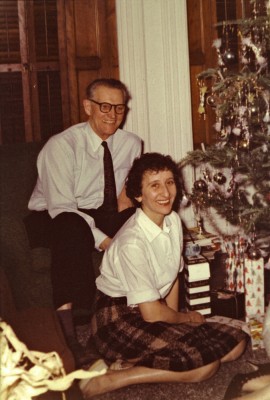 Tissa, after working at Paris based studios, entered New York animation in 1955 at UPA situated diagonally across from the Museum of Modern Art and John and Faith Hubley’s Storyboard, Inc. It was the right place for her.
Tissa, after working at Paris based studios, entered New York animation in 1955 at UPA situated diagonally across from the Museum of Modern Art and John and Faith Hubley’s Storyboard, Inc. It was the right place for her.
There had been few women animators in New York in past decades but, among the men, the held opinion was that women couldn’t do the job. There was also a general attitude that the craft was dominated by Americans. To them animation was a trade for which females and foreigners need not apply. UPA, however, was a progressive studio where the staff included various minorities and nationalities. As one talented African-American artist remarked, “When you walk in here you feel comfortable and welcomed.”
Tissa was greeted by animator Grim Natwick. His European art studies long behind him, he was the choice crew member to interview the then English challenged Tissa. Natwick was direct, ___________Tissa and Grim at Christmas
“What do you think of animation?”
Tissa hesitated , then replied, “Animation is animation.” That satisfied Natwick. Tissa was given a try out on a character from the studio’s popular Piel’s Beer commercials and then hired. The brief meeting with Grim was expressly important because the film that inspired her to get into animation was Disney’s Snow White and the Seven Dwarfs for which Natwick had animated 80% of the lead character. Tissa became Grim’s assistant beginning an association that lasted 35 years.
In time, Tissa became an animator in her own right at local studios giving life to TV commercials. Later came requests from producers with a broader range of diverse characters. These included John and Faith Hubley, R.O. Blechman and Michael Sporn all who came to depend on her animation skills and unique intellectual qualities. Tissa entered a legacy laid down by earlier European animators, illustrators and designers whose influence profoundly effected American cartoons. Working at Disney and Fleischer Studios, their affinity to old world castles, cottages and colorful personalities added credibility, charm and warmth to animated features.
Tissa also played an outstanding role in the ASIFA-East chapter. She organized and corralled the membership lists and dues collections. This was at a time when new graphics guilds were entering the field with lists of 2000 or more, but Tissa proudly managed our 250 or so enthusiatic members.
She was a prime promoter and facilitator of the ASIFA-East Film Festival, and tabulated the voting results as well as commanding the arranging of the event’s refreshment tables. Under her discriminating gaze many of us schlepped wine bottles and tubs of cheese.
I worked with Tissa at various studios around the city and remember a gratifying moment one rainy day when she and Grim came to one of my classes. They had gotten lost in SVA’s internal maze, arriving late and dripping wet. Though tardy, they added substance to the class by answering questions and giving weight to the realities of the field. To the familiar student concern about whether the character of Snow White was traced over live-action actors, Grim, chalk in hand, sketched Snow White to clearly illustrate why her cartooned proportions didn’t allow for rotoscoping.
There’s one anecdote regarding Tissa that I’ve repeated many times, but it still warms my heart, so pardon me if you’ve heard this before. I feel it’s worth repeating since it indicates Tissa’s warmth, humor and life-energizing spirit that rose above everyday twists and turns.
Tissa often traveled to Europe to see family and to animate for small studios. She also had a country house in Southern France. In the spring of 1974, while working in Holland, she contacted Iris and I about attending the animation festival in Zagreb. Her suggestion was that we meet her in Paris a week before the event. She kept a small Volks station wagon there and proposed that we drive across Europe to Zagreb. We accepted gladly. It would be a wonderful journey with a great guide. After a night in Paris we drove south through agrarian countryside evoking the colors of Van Gogh and other post impressionist painters. We stopped in a small town so Tissa could check out her French country place and then we found a small, inexpensive hotel for the night. Tissa suggested that Iris and I take a back room and she a front room. Our lodging was simple, but when we opened the shutters to let in the good night air, we saw the shining moon behind silhouetted castle towers. We slept soundly.
The next morning at breakfast we wondered if she had slept well. “Oh it was terrible!” she replied, “Big trucks rattling past my window all night!” We traveled on through southern France and into northern Italy. One late afternoon we arrived at a local hotel and prepared for a night’s rest before entering Venice. We agreed that this time Tissa would take a back room and we a front room. We slept soundly.
In the morning came our question,” How did you sleep?” It was terrible!” she replied, “There were people playing guitars and singing all night in the courtyard!”
Tissa David will be remembered as a person of taste, humor, artistic skills and a wide understanding of people and the world in general. She observed and interpreted things in a private way. She appreciated much but was opinionated and disdainful of things that didn’t meet her standards. Tissa was a dedicated animator on all manner of productions from workaday TV announcements to celebrated award winners. Though a very private person, she was a friend and mentor to many. She was a treasure in our midst. For all of us who knew and admired her, she will be missed.
Howard’s talk was followed by a clip from Raggedy Ann and Andy
her Candy Hearts and Paper Flowers sequence.
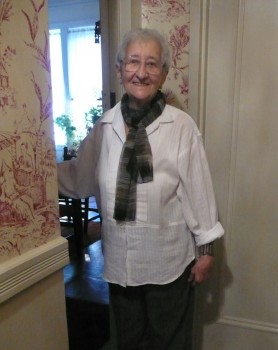 R.O. Blechman was the next speaker. His short talk was planned but spoken off the cuff, improvised. There’s no transcript of it.
R.O. Blechman was the next speaker. His short talk was planned but spoken off the cuff, improvised. There’s no transcript of it.
He started by quoting a poem Tissa liked by T.S.Elliott in which Tissa had substituted the word “animator” for “poet”. Bob also told the story of an article about his show Simple Gifts in which he called the 5 designers, “Artists.” Bob was surprised that Tissa had confronted him by telling him that she was an “Artist” yet there was no mention of her in the promotional article.
Bob’s talk was followed by clips from his studio:
3 commercials for:
– Perrier
– Banco
– WQXR radio
a clip from a promotional trailer for Candide, a film Bob sought to make as a feature.
a clip from The Soldier’s Tale, Blechman’s Emmy winning adaptation of Stravinsky’s work.
Candy Kugel was the next speaker.
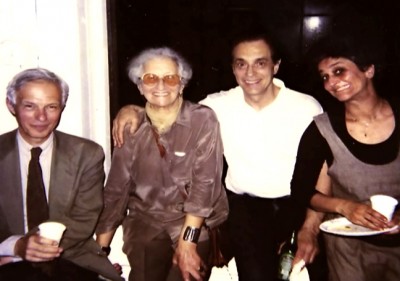 Tissa was my role model—a pathfinder. When I entered the animation industry in the 1970’s there were no other female animators beside her and I was experiencing the same sexist attitudes as she did. And I was in awe of her ability—her fluid line and acting. And finally, I was always grateful for her introduction__________(LtoR) Blechman, Tissa, Vince Cafarelli, Candy Kugel
Tissa was my role model—a pathfinder. When I entered the animation industry in the 1970’s there were no other female animators beside her and I was experiencing the same sexist attitudes as she did. And I was in awe of her ability—her fluid line and acting. And finally, I was always grateful for her introduction__________(LtoR) Blechman, Tissa, Vince Cafarelli, Candy Kugelto international animation and ASIFA.
The first time I was introduced to Tissa was on the telephone in the summer of 1972. I was about to go to Italy for my last year of art school after spending summers interning at Perpetual Motion Pictures.
My boss, the designer Hal Silvermintz, told me that Tissa knew everyone in Europe and she could give me the names of studios so that I could visit them while there. She did, and I did – in Rome, Zagreb and Budapest. And then, since Annecy would have its festival that June, she encouraged me to go and gave me the address to write for certification.
I did go to Annecy and it opened my eyes to international animation in a way I could never have imagined before. There was no internet then, no DVDs and no video collections—the only way you could see these movies was projected in a theater. And I do remember briefly meeting Grim Natwick (who drew me a Betty Boop) and Tissa.
When I returned to New York, it was a bad time for animation so I went to Los Angeles to try my luck there. In New York I had had the good fortune to be treated well by my bosses—my main responsibility was to help the designer.
I had some rudimentary animation experience, but the real animation was done by experienced animators, and they came from a culture of secrecy.
In LA I went to Disney with my “reel†and portfolio and found a whole other set of obstacles. The front gate passes had “Mr.†printed on the guest line. This was during the feminist movement and I jokingly said to the woman behind the window—“I guess you don’t see very many women hereâ€â€”she scratched off the Mr and roughly handed it back to me. I met with 3 men, including Don Duckwall. They told me I drew nicely but that women just don’t have what it takes to be an animator. Women lack timing. Maybe I should consider becoming a designer or background artist.
“But I want my drawings to ACT!†I protested. They smiled and shook their heads.
In the end, I returned to work fulltime at Perpetual. I was determined to learn how to animate well. I got to know Tissa through ASIFA and she offered to help me.
Perpetual picked up a project that had an incredibly low budget, so they gave it to me. Whatever I could manage would be enough. Vincent Cafarelli had recently started freelancing there, and although he was open to helping me, he encouraged me to seek out Tissa’s advice. They had worked together at UPA and he had great respect for her. He even told me I flipped like her.
Tissa invited me to her home and she demonstrated some things. And gave me homework. I went a few more times—I wish I could say that I was a stellar student, but I’m afraid her criticism, although completely deserved, was too biting for my fragile ego.
She was my idol—I loved her work – her beautiful line and her acting. I respected her immensely—but I think I must have been a great disappointment to her. At that time, I was the only girl working her way to become an animator in an established animation studio in NY. I imagine she was hoping for a protégé equal to her talents.
But even without the lessons we remained friends. She followed my career closely and we worked together in ASIFA.
We both understood the difficulty in working in a “man’s profession.†I was criticized by the ink and paint department for not being one of the girls—I was a guy because I used a pencil and not a brush. Outside of Perpetual there were animators and assistants who thought it wrong of me to take a man’s job. Some kiddingly said they would “break my fingers.â€
I admired Tissa even more, knowing exactly what she had been through.
But we never spoke about it after our first meeting at her apartment: I gingerly asked her about how she dealt with the male animators—their practical jokes, the macho culture–were there rumors about her and Grim? She looked at me harshly and waved her hand. Who needed to complain—it was just part of the job.
I will miss Tissa—her generous spirit, her biting wit and her talent. There are too few of them out there.
Candy’s talk was followed by clips from 3 films done for Michael Sporn Animation:
Lyle Lyle Crocodile
The Red Shoes
The Story of the Dancing Frog
Arlane Nelson was the next speaker.
- As Michael said, I am one of Tissa’s nieces. An interesting side note, Tissa was one of 10 children, 7 girls, 3 boys. In my generation, the next one, there were only a total of 3 girls among all the nieces and nephews.
I’d like to begin with an email one of my Hungarian cousins sent me:
“Tissa was known to love music, and we had talked a lot about our favorite performers: Horowitz, Goild, and many other artists. However one thing that is not common in elderly people, is to be open to new things, as Tissa had been. Once I saw a movie about the life of Manuel de Falla, which has a lot of music inserted, one even recorded during his short life. The recording is very interesting because when Falla wrote his masterpiece, El Amor Brujo, he wanted to reject it because the passion radiating from the piece is in total contrast with his deep catholic faith.
Manuel de Falla, just as Kodaly did, collected folk music, the music of the flamenco playing gypsies. El Amor Brujo totally gives back this surreal feeling. In the movie, in order for the illustration to be perfect, two songs, that are accompanied by a large orchestra, were sung by a young female gypsy singer with the technique typical to flamenco. The passion radiating from the recording is scary. I showed it to Tissa who said that this woman is like a storm. And she started telling me stories about being in Andalusia, listening to flamenco music, and how much she liked it.
The other memory is connected to flamenco as well. Many people think that they like this musical style, while they only meet the civilised versions. I have watched Saura’s movie, called Flamenco in which there is a part when two old gypsy men sit on a chair and sing without music. One of them has golden teeth, the other one has silver teeth. This is of course not singing according to European standards, this is rather some endless, sharp, painful, and aggressive shouting, confined among borders. As far as my experience goes, only a few can understand this deepness of art. Tissa understood it, we talked a lot about it later on, and she pointed out the complicated symbols in the text that I had missed on my own.â€
Anyway, I live in the Washington metropolitan area and as such, we used to see Tissa a lot; more than any of our other relatives. She’d be down to visit us several times a year and sometimes, we came up to visit her. I’d like to share a few of my memories of who Tissa was.
Growing up, we kind of knew that Tissa was a famous person and we were very proud of this. I can remember, when my sister and I were small and Tissa came to visit, we had to wait until the morning, but we would go charging in and have her tell us the latest Letterman shorts she had done. So we’d know the stories before anyone else did.
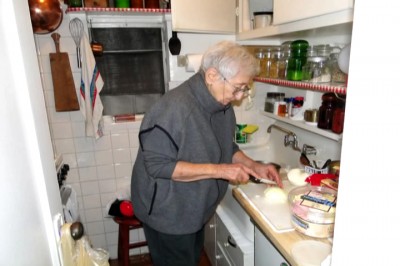 Tissa loved cooking. Whenever she came to visit, she took over the kitchen; you entered at your own risk. Except for the dogs, who usually waited in endless vigil watching every step, every action with rapt attention for the treasures they knew would fall. One of the things I found__________Tissa cooking in her NY kitchen
Tissa loved cooking. Whenever she came to visit, she took over the kitchen; you entered at your own risk. Except for the dogs, who usually waited in endless vigil watching every step, every action with rapt attention for the treasures they knew would fall. One of the things I found__________Tissa cooking in her NY kitchen
inexplicable was her use of
cooking implements which would increase exponentially with availability. A dish she would make in her tiny kitchen might take 2 bowls and a pot. The same dish in our house, could take 7 bowls, 5 pots, and 3 pans. Any time you walked in to the kitchen, all burners would be going, some would even have two things on at the same time. A couple of things would be waiting on the side for a burner to free up, some other dishes would be done, there would be something at the chopping board in mid process, and usually a vegetable of some kind hanging out in a colander in the sink. Or trying to get a recipe from her was always a challenge. For example, when she was trying to explain how to make galuska to us: You started with a cup of flour and one egg. Then you added milk. Okay. So, how much? Well, as much as it takes so that if you stick a spoon straight up into the batter, it would fall over very slowly. There was another time I wanted to make Beigli for Christmas. Tissa said she would send me my aunt Dusi’s recipe because it was the best. Again, you started with 70 decagrams of flour, grated in some lemon rind and then sour cream. How much? Well, this time you had to add just enough so that the dough would behave when pinched like an old woman’s skin. Needless to say, without centuries of Hungarian cooking practices ingrained, whenever I did anything with Tissa, I ended up taking a novel’s worth of notes.
I remember once having a conversation with Tissa in which she quite definitively stated that it was a shame Scotsmen wore kilts as they had some of the ugliest knees in the world. I want to say that she thought the Germans or Dutch would have been better suited. Despite his having ugly knees, tho, Tissa admitted to a fondness for Sean Connery.
Tissa was also a very generous person. We were always welcome at her place as long as you did not mind the conditions. Anyone who was ever at her apartment knows it was rather small. But we would make it work. I remember one time when I was 8 or 9, there must have been 7 of us there. I can still see myself picking my way carefully across the floor of sleeping bodies to get to the bathroom. My children especially looked forward to our New York trips: the rules of living conditions were suspended and there were so many things to engage little minds. Then when my mother was sick, Tissa packed up and moved in for as long as it was going to take helping to take care of my mother so that she could have her wish of dying at home. It was this same wish of Tissa’s, I’m glad I had some part in returning.
Another thing that was important to Tissa was her faith. She always had this quiet, laid back, do what you are going do attitude. I always thought it was part of the reason she seemed so at peace with things, even her death. No matter what else happened or changed, Tissa had this. She was very different than my mother in this way. Tissa didn’t fly off the handle, or ram things down your throat, or sweat the small stuff. She knew what was important to her and the rest didn’t bother her. Tissa also was very adamant that my sister’s memorial marker have a cross. Despite my sister’s claims to atheism, Tissa was convinced that Tamar found redemption in the end.
Before I had children, I used to go to the movies every weekend, so, Tissa and I would compare notes on films we had seen. Very often, they would be showing in New York weeks before the artsy theaters in DC picked them up, so Tissa would let me know what to add to my list. However, we often found we had different sensibilities. One such film was The Triplets of Belleville. Tissa told me I had to see it: it was wonderful not only as an animated film but also for the story of the boy and his grandmother. After I saw it, I called Tissa and told her that yes, it had been a wonderful film, but she should have warned me about the frogs. Tissa paused a moment and then said “Oh, yes, the frogs. That was a very funny scene.†I responded “No, it wasn’t funny, it was tragic and you should have prepared me.â€
Tissa did not like technology, but accepted it as a necessary evil. However, she refused to take the time to understand how things worked. Many times when I came up to see her, Tissa would have some contraption that she needed me to install or set up: an answering machine, a VCR, an antenna, the HD receiver, a hand held sudoku game, etcetera. Once I was done tho, she didn’t want to know the details, just the buttons she needed to press. We tried for years to get her onto email, but she wouldn’t hear of it. There would be no computers, no cell phones, no tablets, nothing of that kind ever with Tissa.
The last time I brought my children up to see Tissa – at the end of July – you could see how happy it made her to sit and watch them play. She always enjoyed the children in her life, even after we thought we had grown up. She was kind and nurturing and a mother to us all. Whether she was teaching us, encouraging us, forming us, feeding us our favorite creamed spinach, or just loving us. She was an important fixture in all our lives and one we will make sure no one ever forgets.
Arlane’s talk was followed by a long clip from a film Tissa animated for me,
The Marzipan Pig.
My speech followed. It was the last of the evening. I gave it extemporaneously, and there is no transcript of it. I tried to be as funny as I could, and that worked. The following is the original speech I walked in with. It’s not good, bathetic and inapropriate for the final talk. My changes worked. To give an indication of the final, though, I’ve decided to leave this here.
Michael Sporn
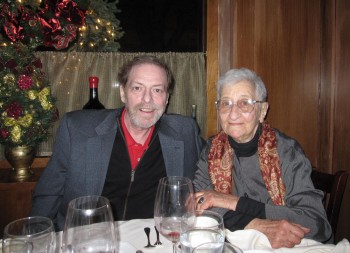 Forty years ago, on Tuesday Oct 10, 1972, 1 had just started my second day in animation working for John and Faith Hubley. I was scheduled to work three days to help finish a commercial. Helen Komar was the only other person working on that commercial with me. She was the production coordinator. My second day there, and I was working as intensely as 1 could. 1 loved being there, I was finally doing animation and getting paid for it.
Forty years ago, on Tuesday Oct 10, 1972, 1 had just started my second day in animation working for John and Faith Hubley. I was scheduled to work three days to help finish a commercial. Helen Komar was the only other person working on that commercial with me. She was the production coordinator. My second day there, and I was working as intensely as 1 could. 1 loved being there, I was finally doing animation and getting paid for it.
That day, 1 continued to work through my lunch break; I wanted to get it right. That’s when T heard this voice with a sharp Hungarian accent say loud enough, “Who has been doing such HORRIBLE inbetweens?” Sheepishly I looked up and had to admit that we all knew she was talking about me. Especially since I was the only one doing inbetweens. That’s how I met Tissa David.
Tissa proposed I come to take lessons from her; she would help teach me what she could about animation. This meant I spent a lot of time doing homework that Tissa would give me inbetweening over and over and over again animation drawings that were usually from a scene that Grim Natwick had animated. Back then, Tissa had a sharp way of telling you how bad you were. It didn’t take me long to find the humor in what she had to say, especially since 1 was even more of a critic of my own work than she was.
Things changed a bit over the years. Tissa grew more and more reserved with her opinions. She made an obvious attempt to moderate herself when she thought it was too harsh. However, I always tried to encourage her to fully express what she thought about my work, and I like to think she was honest with me throughout.
Somewhere along the line I stopped asking for help with animation. Slowly we became more friends rather than teacher and student. When she left the Hubley studio to work for Richard Williams on Raggedy Ann, knowing full well that I was a big fan
of Dick Williams’ work, she maneuvered a job for me on the production. Starting as an inbetweener, I worked my way up to the position of head of Assistants and Inbetweeners.
After that, I was hired by Bob Blechman to be his Asst Director working on a Christmas Special. Before we got to that we did a number of commercials together. Once Bob had difficulty finding an animator, and 11 talked loudly and enthusiastically about Tissa’s work. She soon started working with Bob in a relationship that lasted years.
When I formed my own studio, I directed a number of half hour shows. Tissa was happy to work for me in many capacities. She did storyboard, layout and sometimes animation. We helped each other often by just being there. That made a lot of the jobs more fun, and helped me feel even more proud of the work I was doing.
The last couple of years weren’t about animation, really. Yet the two of us were able to keep laughing throughout. And talking. Talking about museum shows and films that we saw. Sharing books we’d read or just sometimes talking. I was never much of a phone person so it had to be face on.
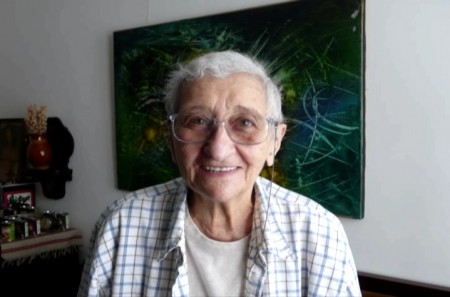
Tissa in her Living Room
Photo by Mate Hidvegi
In the end 1 learned that Tissa had developed a brain tumor. Of course, I didn’t know whether that meant she would have a long slow death or a quick one. 1 went one Saturday afternoon and laughed quite a bit with Tissa. When I brought up old names and places and events, she remembered them clearly. If she tried to remember something, she couldn’t, and the conversations would end flat. It meant I had to keep talking.
I left that afternoon and expected to return five days later. But that day I got a call from Susan Davis telling me that Tissa had died that day. She didn’t feel well in the morning, lay down for a while, and didn’t wake up.
I think her passing won’t really hit me for a while. I’ve been spending a lot of time editing this footage. Now this memorial is done, and I think the reality won’t hit home until Christmas. Every year, I’ve received a wonderful fruit cake from Tissa. In fact, I still have a couple unopened. I know that one won’t arrive this year, and I’ll miss my fruitcake this year.
This talk was followed by the last animation work Tissa did,
part of the animatic for my feature, POE.
.
.
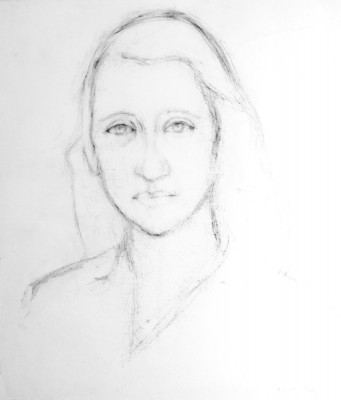 1
1
a 1942 drawing by Tissa’s close friend, artist,
Judit Reigl. The drawing is in the collection
of Tissa’s sister, Katalin David.
Thanks to Mate Hidvegi, Katalin’s son, for sending it.
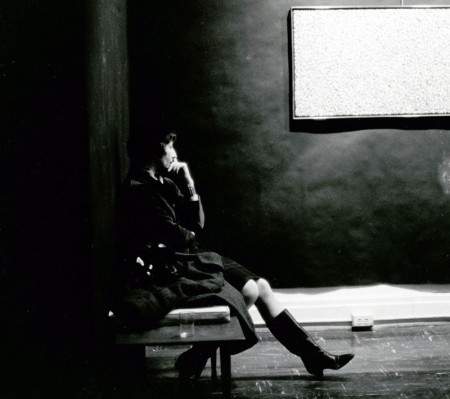 2
2
Tissa in an Art Gallery in the 60s
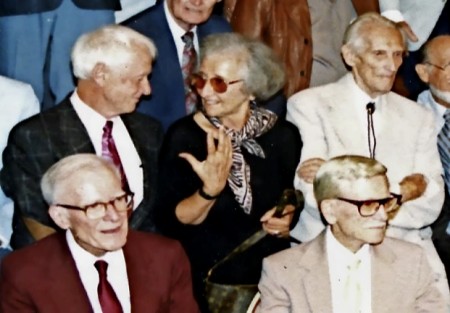 3
3
At Grim Natwick’s 100th birthday
(L to R) Duane Crowther, Tissa, Grim Natwick
in front of them: Frank Thomas, Virgil Ross
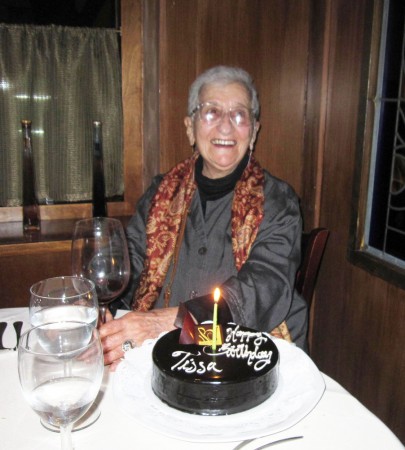 4
4
Tissa on her 90th birthday celebration dinner
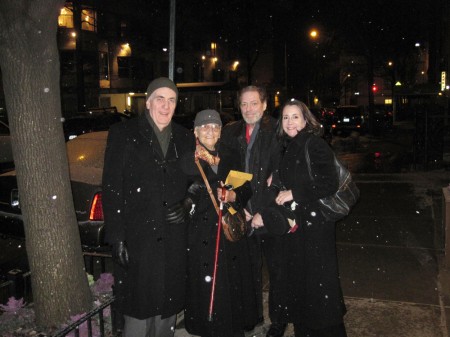 6
6
(L to R) John Canemaker, Tissa, Me, Heidi Stallings
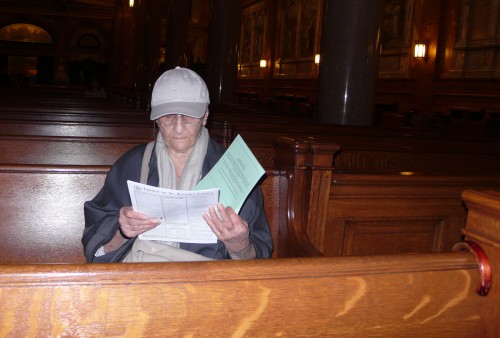 7
7
Tissa in St. Ignatius Loyola Church, 84th St, Madison Ave.
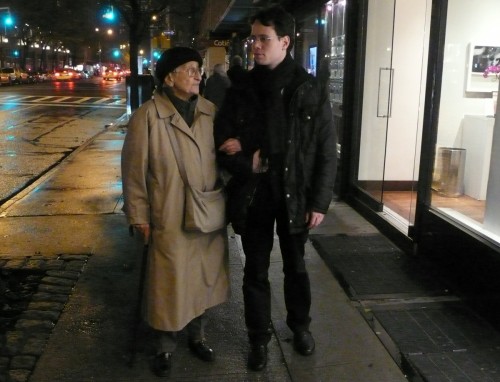 8
8
Tissa with Aron Hidvegi, her grand nephew
4, 5, & 6 photographed by Joe Kennedy
7, 8, 9, 11 & 12 photographed by Mate Hidvegi
10 photographed by Aron Hidvegi
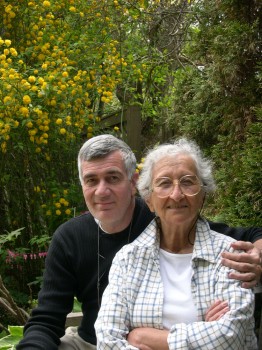
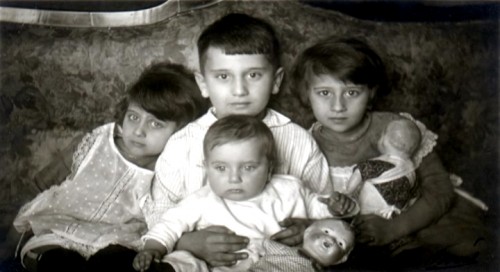
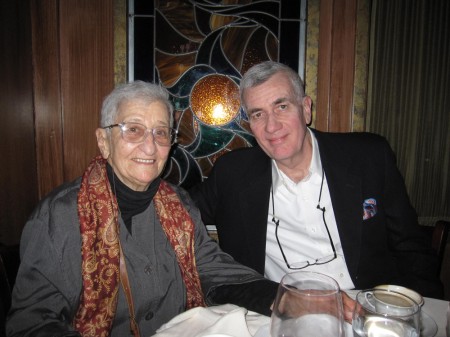
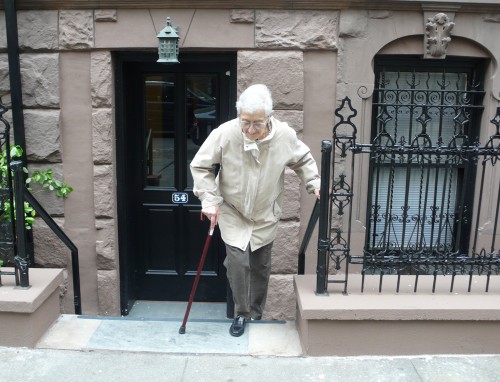
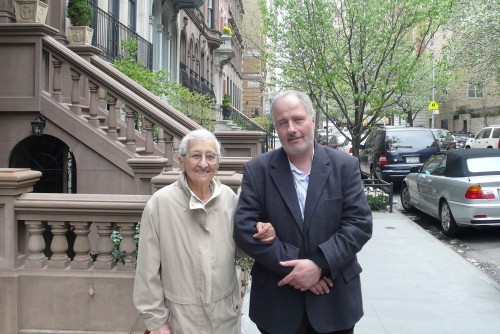
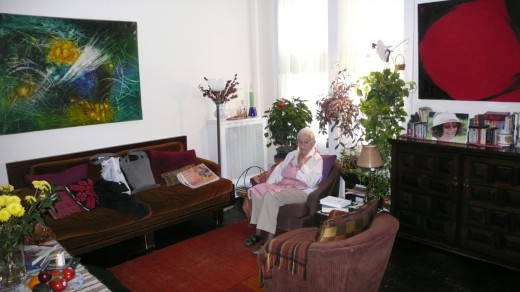
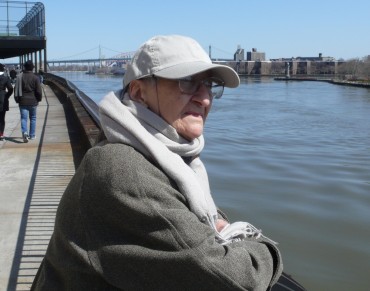

on 05 Nov 2012 at 4:08 pm 1.Mark Kausler said …
Hi Mike,
Thanks for the great coverage on Tissa David. By the way that’s DUANE Crowther in the picture with Tissa And Grim not DWAYNE. I am currently running his letters to Bob Balser on my blog which is http://www.itsthecat.com/blog. Please come and visit.
Yours, Mark Kausler
on 05 Nov 2012 at 11:44 pm 2.the Gee said …
I seriously doubt I’m the first to say that it seems like you did right for her life and the memory of her.
If I am then, man, it really should go without saying that you did right for her. It is a fitting tribute by those close to her. It is impressive to see what you and others did to commemorate her. Some should be so fortunate to have touched people like she seems to have.